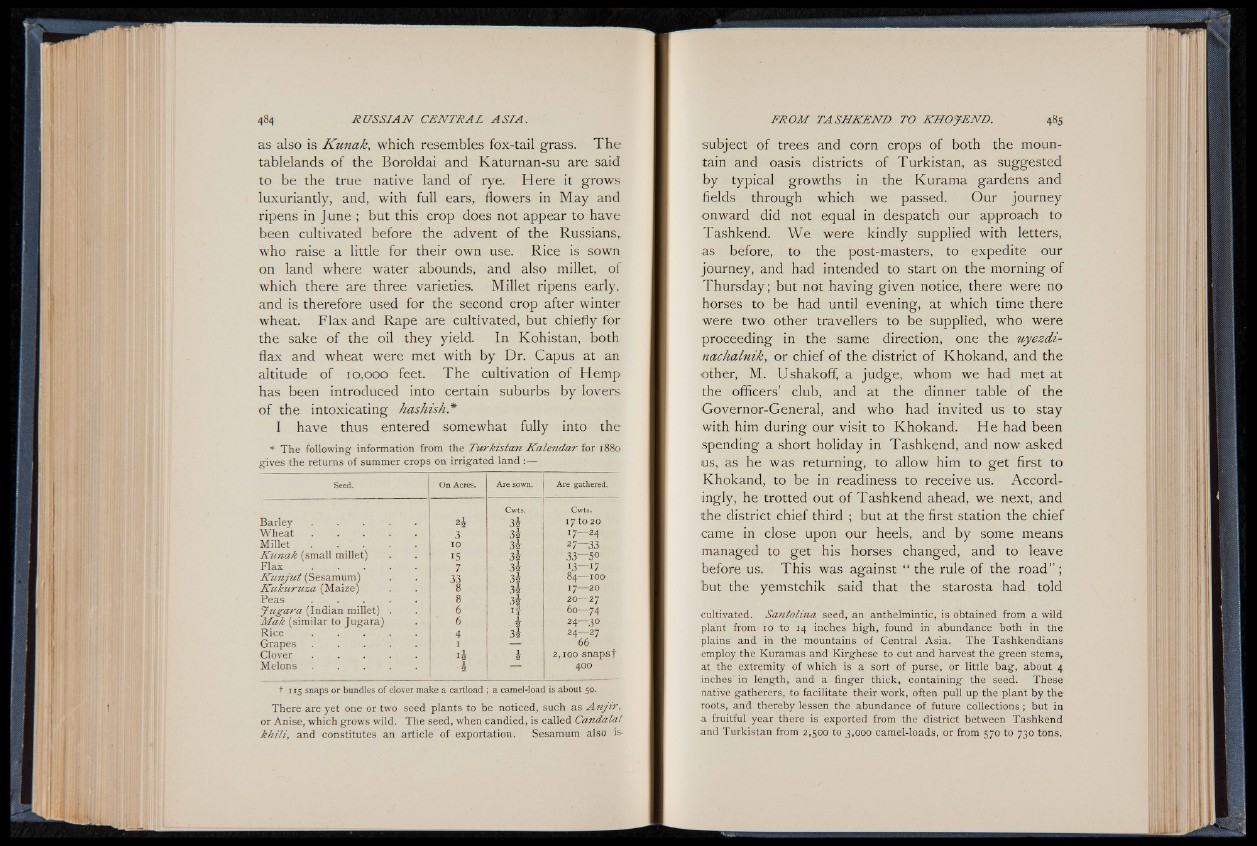
as also is Kunak, which resembles fox-tail grass. T h e
tablelands of the Boroldai and Katurnan-su are said
to be the true native land of rye. Here it grows
luxuriantly, and, with full ears, flowers in May and
ripens in June ; but this crop does not appear to have
been cultivated before the advent of the Russians,
who raise a little for their own use. Rice is sown
on land where water abounds, and also millet, of
which there are three varieties. Millet ripens early,
and is therefore used for the second crop after winter
wheat. Flax and Rape are cultivated, but chiefly for
the sake of the oil they yield. In Kohistan, both
flax and wheat were met with by Dr. Capus at an
altitude of 10,000 feet. The cultivation of Hemp
has been introduced into certain suburbs by lovers,
of the intoxicating hashish*
I have thus entered somewhat fully into the
* The following information from the Turkistan Kalendar for 1880-
gives the returns of summer crops on irrigated land
Seed. On Acres. Are sown. Are gathered.
Cwts. Cwts.
Ì2
Barley . . . . . ,1 3i 17 to 20
Wheat . . . . . 3 3Ì 1 7 2 4
Millet . . . . . 10 3i 27— 33
Kunak (small millet) 15 3i 33— 50
Flax . . . . . 7 3ì 13— 17
K u n ju t (Sesamum) 33 3i 84— 100-
Kukuruza (Maize) 8 3i 17---20
Peas . . . . . 8 3i 20— 27
Jugara (Indian millet) . 6 i f 60--- 74
Mak (similar to Jugara) 6 24— 3O
12
Rice . . . . . 4 3i 24— 27
Grapes . . . . . i — 66
Clover ........................................ ï à 2,100 snap sf
Melons . . . . . •.— 400
t 115 snaps or bundles of clover make a cartload ; a camel-load is about 50.
There are yet one or two seed plants to be noticed, such as A n jir ,
or Anise, which grows wild. The seed, when candied, is called Candalat
khili, and constitutes an article of exportation. Sesamum also issubject
of trees and corn crops of both the mountain
and oasis districts of Turkistan, as suggested
by typical growths in the Kurama gardens and
fields through which we passed. Our journey
onward did not equal in despatch our approach to
Tashkend. We were kindly supplied with letters,
as before, to the post-masters, to expedite our
journey, and had intended to start on the morning of
Thursday; but not having given notice, there were no
horses to be had until evening, at which time there
were two other travellers to be supplied, who were
proceeding in the same direction, one the uyezdi-
nachalnik, or chief of the district of Khokand, and the
other, M. Ushakoff, a judge, whom we had met at
the officers’ club, and at the dinner table of the
Governor-General, and who had invited us to stay
with him during our visit to Khokand. He had been
spending a short holiday in Tashkend, and now asked
us, as he was returning, to allow him to get first to
Khokand, to be in readiness to receive us. Accordingly,
he trotted out o f Tashkend ahead, we next, and
the district chief third ; but at the first station the chief
came in close upon our heels, and by some means
managed to get his horses changed, and to leave
before us. This was against “ the rule of the road” ;
but the yemstchik said that the starosta had told
cultivated. Santolina seed, an anthelmintic, is obtained from a wild
plant from 10 to 14 inches high, found in abundance both in the
plains and in the mountains of Central Asia. The Tashkendians
•employ the Kuramas and Kirghese to cut and harvest the green stems,
at the extremity of which is a sort of purse, or little bag, about 4
inches' in length, and a finger thick, containing the seed. These
native gatherers, to facilitate their work, often pull up the plant by the
Toots, and thereby lessen the abundance of future collections; but in
a fruitful year there is exported from the district between Tashkend
and Turkistan from 2,500 to 3,000 camel-loads, or from 570 to 730 tons.